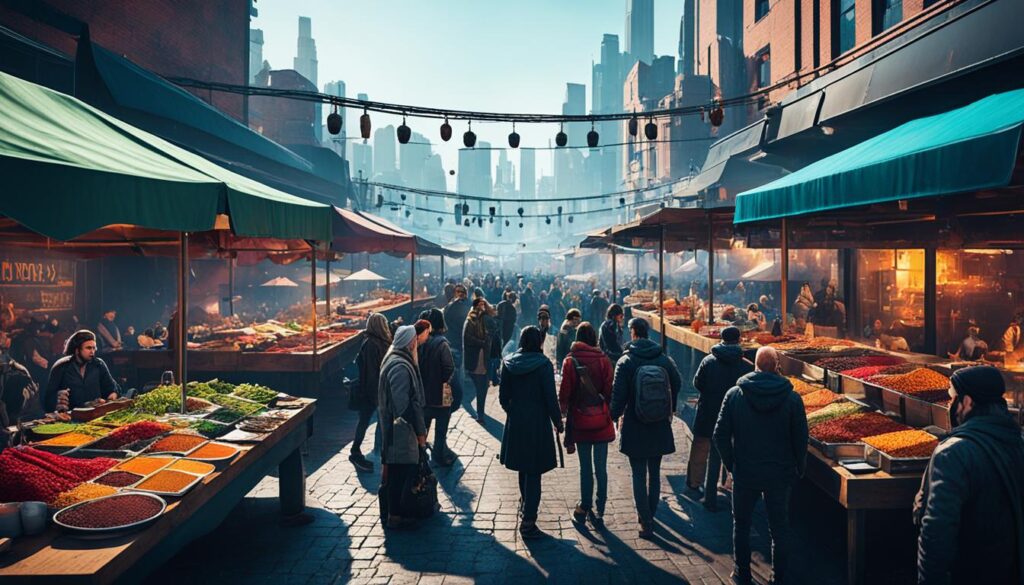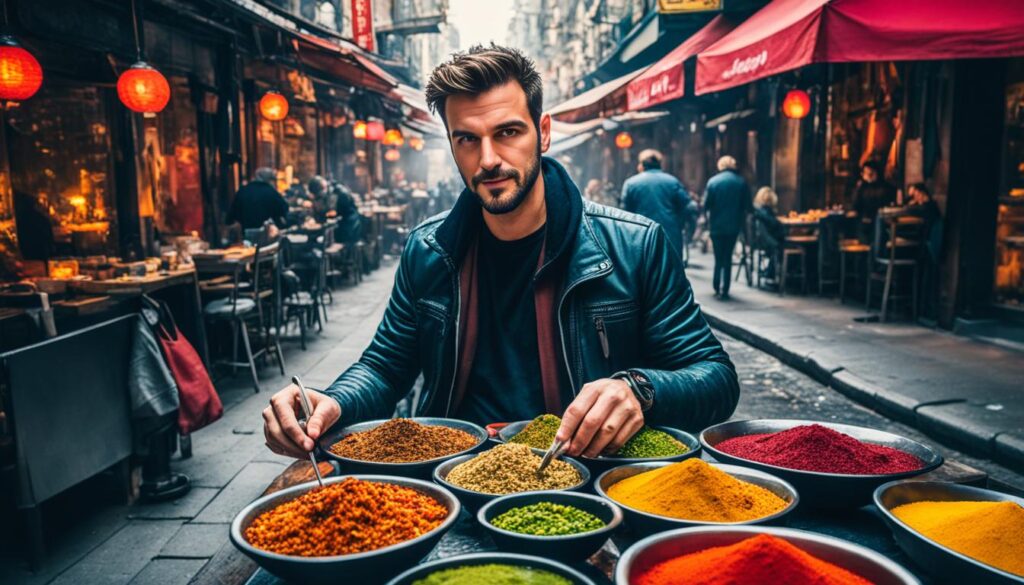Have you ever felt the thrill of finding a hidden gem of a restaurant? The flavors there dance on your tongue, taking you to a new world. In the world of food tourism, solo travelers find a treasure trove of culinary adventures. Let’s dive into the art of solo dining. You’ll learn to enjoy freedom, navigate cultural differences, and make new friends through food.
Are you a food lover or just curious about new tastes? This journey will inspire you to start a culinary adventure. You’ll discover hidden spots meant just for solo explorers. Get ready to awaken your senses and enjoy a world of flavors that will touch your heart and taste buds deeply.
Embracing the Art of Solo Dining
Dining alone can change how you see food, giving you the chance to dive deep into flavors. It’s perfect for exploring new places or just taking a moment to think. Solo dining lets you enjoy food at your own pace, without having to please anyone else.
Benefits of Exploring Cuisines Alone
When you eat alone, you’re in charge of what you eat and when. You can enjoy each bite fully, trying flavors you love without any pressure. This freedom lets you try new foods and taste what catches your eye.
Also, eating alone helps you soak in the local culture. You can watch the city, talk to locals, and learn about their food and traditions. It’s a way to connect deeply with a place.
Overcoming the Stigma of Eating Out Solo
Some might feel shy or worried about eating alone in restaurants. But it’s important to see the value in eating alone. Remember, you’re not the only one enjoying solo dining; many travelers love exploring food on their own.
By being brave in restaurants, you’ll find that people don’t judge you. Instead, you’ll feel free and excited to try new foods. It’s a chance to learn more about the world and what you like.
Food tourism: Uncovering Culinary Gems
Start a tasty journey into food tourism and find the best local dishes. Whether you love to travel or explore new foods, learning how to find hidden spots can make your trips special. It can also make your taste buds happy and give you memories to cherish.
Researching Local Specialties and Hidden Gems
Diving into local food is a great way to feel the culture of a place. Begin by looking up the area’s famous dishes and how they’re made. Use online reviews, food blogs, and social media to find spots that locals love. Look for family-run places, street food, and markets to really get the taste of food tourism.
Talking to locals can also help you find great food. Ask hotel staff, tour guides, or friendly people for tips on what to eat. They can point you to the best dishes and places for local cuisine. Their advice can lead you to the most genuine and tasty food experiences.
“Exploring the local food scene is not just about satisfying your taste buds – it’s a window into the heart and soul of a destination.” – Anthony Bourdain
With research and local tips, you can discover a world of culinary exploration beyond the usual tourist spots. Dive into the unique flavors of the area and make memories that will make you want to go back for more.
Navigating Cultural Differences with Respect
When you travel alone and try new foods, it’s key to respect and understand the local culture. Learning about cultural awareness, etiquette, and culinary customs makes your meals better and shows you care. This respect is important for a good experience.
Knowing how to act at the table is crucial. In some places, wait for the oldest person to start eating. In others, it’s okay to try different dishes at once. Learning these rules helps you avoid mistakes and be polite.
Etiquette is also important when you meet locals. Learn how to use chopsticks and know which utensils to use for each dish. Showing respect for their ways can make your visit better and open up new experiences.
“Embracing local culinary customs is a gateway to understanding and appreciating the heart and soul of a culture.”
Talking to locals and showing you value their food can lead to special moments. Ask for food tips from your server or a friendly local. Trying new foods and being open to new tastes is a great way to connect with people.
Respecting cultural differences lets solo travelers dive deep into the world of food. It helps build strong connections and memorable experiences.
Building Connections through Food
Food has a special way of bringing people together. It goes beyond just eating; it creates strong bonds. As a solo traveler, you get to meet new people and make friends through food. This lets you see things from different viewpoints and connect deeply with locals.
Forging Friendships with Fellow Foodies
Traveling alone lets you meet others who love food just like you. You might talk to someone at a restaurant or join a food tour. These moments can turn into friendships that last a lifetime. *The shared love for food breaks the ice, leading to deep talks and sharing stories.*

Engaging with Local Communities
Getting into the local food scene helps you understand a place better. You can take cooking classes, go to food festivals, or join events. *These activities not only broaden your food knowledge but also make you feel like you belong. You connect with locals on a real level.*
“Food is the universal language that brings people together, regardless of their background or nationality.” – Celebrity Chef, Julia Child
Food helps you make connections and understand a place’s culture. It makes your trip memorable and enriches your experience.
Developing a Refined Palate
Start an exciting journey of culinary education and taste exploration. Learn to identify and enjoy the subtle flavors and textures of different dishes. This way, you can truly enjoy your meals.
Improving your palate means more than just trying new foods. It’s about learning to notice the fine details of taste and smell. Begin by focusing on one type of food or ingredient. Learn about its flavors and how different cooking methods can change them.
Pay close attention to each dish you eat. Notice the first flavors, how they change as you chew, and the taste that stays after. This will help you understand what makes a meal special.
- Try different flavor mixes and cooking ways to learn how ingredients work together.
- Take culinary education classes or workshops to learn from chefs and explore various cuisines.
- Join wine and cheese tastings to get better at noticing different flavors.
- Keep a journal of your food experiences. Write down what you taste, feel, and think about each dish.
Getting better at tasting is a journey of discovery. With each new food experience, you’ll grow to love the art of flavor profiles and the fun of taste exploration.
Capturing Culinary Adventures
As a solo traveler, your food adventures are more than just eating. They are a chance to capture beautiful moments. Food photography lets you keep the taste, look, and feel of the dishes you try. It’s a way to share your solo travel food experiences with others.
Food Photography Tips for Solo Travelers
Learning food photography can make your food stories come alive. It turns your solo travel into a visual diary. Here are some tips to improve your food photos:
- Lighting is key: Look for natural light to make your food look vibrant. Stay away from harsh lights that create dark shadows.
- Composition is crucial: Try different angles and add props like utensils to make your photos interesting.
- Capture the details: Zoom in on small parts of the dish, like garnishes or ingredient textures, to show the chef’s skill.
- Tell a story: Include the setting and people in your photos to show the whole dining experience.
- Edit with care: Use editing tools to make your photos better, but don’t overdo it. Small changes can make a big impact.
Your food photography should do more than just document your meals. It should inspire others and share the unique tastes and experiences of your solo travel journey.
“A picture is worth a thousand words, and in the world of food, a well-captured image can transport someone to a different time and place, stirring their senses and sparking their curiosity.”
Planning Solo Culinary Excursions
Starting your solo culinary journey requires careful planning for a safe and fun trip. You’ll need to think about how to get around, where to stay, and how to handle food and language differences. A bit of prep work can make your solo food adventures stand out.
Essential Tips for Safe and Enjoyable Experiences
Here are some key tips for your solo food trips:
- Research your destination thoroughly. Learn about the local ways, laws, and safety tips to feel confident in your new place.
- Book accommodations that cater to solo travelers. Choose hotels, hostels, or Airbnb places that are welcoming to solo guests.
- Map out your transportation options. Look into the local buses, Uber, or car rentals to make your food tours easy.
- Identify solo-friendly dining establishments. Find restaurants and food spots that are great for eating alone.
- Communicate dietary requirements and preferences. Tell people about any food allergies or special diets to have a good time eating out.
- Learn essential phrases in the local language. Know basic words like greetings and how to order food to help you out on your trip.
- Stay connected and share your itinerary. Tell your friends and family where you’re going and check in often to stay safe.
With these tips, you can go on solo food adventures with ease. You’ll get to try new flavors and keep safe and happy at the same time.
“Culinary tourism is not just about the food, but the entire cultural experience. As a solo traveler, embracing this aspect can make your culinary adventures truly unforgettable.”
Embracing Spontaneity and Adventure
Start your solo food journey with a sense of spontaneity and adventure. Be ready for unexpected finds and the excitement of exploring new things. Let your taste guide you as you explore food tourism, finding hidden spots and new tastes.
Enjoy walking through busy markets, finding small cafes, and talking with food lovers. Dive into the culture and traditions that make the food special. Try new dishes and let your taste buds surprise you.
Stay curious and flexible, as the best food experiences come from being spontaneous. Go on food tours by chance, listen to what locals suggest, and let your gut lead you. Embrace the unknown and let your solo food adventure be full of culinary spontaneity, food discovery, and solo travel.

